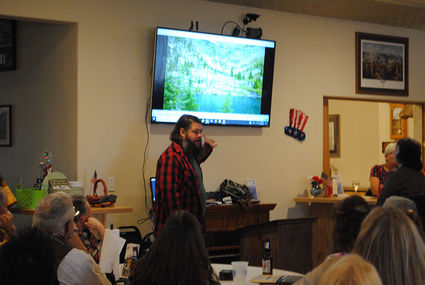Backcountry group shares tails and trails
July 5, 2018

Justin Harris
CUBE IRON CATARACT COALITION'S Zach Whipple-Kilmer guided viewers through a slide show and video prepared from images captured by Andrew Klaus. The big sky scenery is home to a plethora of wildlife and a second home to outdoor enthusiasts. The group aims to ensure current access and use remains the way it is.
It is not a "wilderness group," but their interest in the continued reasonable use of wild lands is second on their priority list. Presently, the number one goal of Cube Iron Cataract Coalition (CICC) is to create awareness of the backcountry mix of roadless areas, connecting backcountry, and lands bordering National Forest. Membership and support from the group enjoys an overlap with the Backcountry Horsemen, Montana Wilderness Association and Montana Backcountry Hunters and Anglers – many of whom were in attendance and helped with the execution of the "Backcountry Tails and Trails" event.
CICC welcomed the community to join them for dinner at the Elks Lodge in Thompson Falls, as well as special presentations from experts whose office is wherever they may roam outdoors. A slide show created from pictures and video collected by avid hiker and talented photographer, Andrew Klaus, gave visual emphasis to the value of the treasured lands CICC is focused on. CICC's Zach Whipple-Kilmer introduced the video and narrated the scenes for the crowd by identifying peaks, lakes and streams on the screen.
"These are just some of the breathtaking views we have right in our backyard, and the recreational use of these treasures is something special we have in this place we call home," shared Whipple-Kilmer, adding that CICC encourages residents, visitors, hikers and nature lovers to utilize those areas to view and hunt wildlife.
The group supports hunting, fishing, trapping, hiking, mountain biking, motorized recreation in appropriate areas and other legal activities in the backcountry. CICC has no intention of allowing the access to be closed off from public use. Maintaining 'the way things are today' is the group's purpose.
While residents may call this area home, there are some who truly live their lives here. There is no shortage of wildlife in these mountainous areas, with habitats ranging from steep mountain cliffs for mountain goats and riparian areas supporting a complex variety of animals. Big horn sheep, mountain lions, and the occasional roaming grizzly bear are just a few of the larger mammals found in this focused backcountry that stretches from the west side of Thompson River to Vermilion near Trout Creek.
Guest speaker Kylie Paul, specialist in regional wildlife, is currently contracted to specifically study wolverines. Her experience studying wildlife in the region has taken her on research studies for marmot, marten, lynx and fisher, among others.

Many will remember over a decade ago when the furry, white majesty of mountain goats could be spotted dotting the cliffs near Highway 200 by Thompson River. "Those guys are still around, they've just moved farther in and higher up," said Paul, who added that there isn't a known reason for their northern migration from old stomping grounds, and that mystery is nearly as perplexing as the drastic drop in numbers in big horn sheep in the CICC area.
"The lands CICC is focused on are home to its very own herd of big horn sheep. These photogenic animals will stand still for pictures, but they are always on the move," noted Paul, who coordinated with Bruce Sterling, wildlife biologist from Montana Fish, Wildlife and Parks.
Sterling backed up Paul's assessments on the high-terrain ungulates and added that mistakes had been made in the past that contributed to the low numbers of mountain goats in the area. "In the 60s, the mountain goat population was flourishing, and hunting of the animals was popular. As logging roads were punched in their habitat, there was more access to those areas and the mountain goat numbers weren't taken into account, nor were any kind of hunting restrictions changed to deal with the easy access by more hunters. In hindsight, we see that they were simply overharvested."
Sterling added that mountain goat communities are lead by a matriarchal "nanny," who makes decisions for the herd about where to travel and where to graze. "Those nannies were consistently harvested, which probably lead to a lot of confusion and unneeded stress to the herd's habits and cycles."
Always a popular local wildlife topic, the plight of the big horn sheep whose numbers have declined alarmingly in recent years – from around 275 head in 2008 down to an estimated 70 presently. Brucellosis, other sickness, and vehicle collisions are all factors in their diminished population.
Male grizzly 926 is just one of the many bears U.S. Fish and Wildlife Service's Wayne Kasworm has tracked in his decades of following bears and bear movements. "I remember the days when I had to get in an airplane in order get a hit from a radio collar on a bear," said Kasworm. "Nowadays, thanks to satellites and GPS, I can get a 'ping' from numerous collars every three hours and have the results sent to my email and phone. Despite that ease, I still like to get outside."
Grizzly bear 926 was tracked in 2017 and the map of his travels showed that he spent quite a bit of time traveling through CICC backcountry – even denning at Graves Peak in Deep Creek, about 12 miles north of Thompson Falls. "Grizzly bear population growth is at about two percent, that's about a bear per year for our current count of around 50," said Kasworm. "As we can see from the maps showing their travels, the males get around and travel a lot, it is the females who tend to settle in an area, and their offspring traditionally claim a territory adjacent to moms. Their boundaries get bigger as the family tree grows. Of course, this is all dependent on males making their rounds and doing their thing."
Interestingly, introduced bears will often journey hundreds of miles in a year and arrive at nearly the spot where they were originally picked up. Also interesting, is that those bears don't stay "home," but turn around and wander to nearly the exact spot where they were introduced to a new area.
Augmentation of grizzly populations only works if the bears survive. Another challenge arises when a tracked bear slips their collar. The chore of following them becomes harder, but not impossible. Hair samples on rub areas where bears like to scratch give clues.
An introduced sow named Irene, who held a lot of promise for tracking in 1995, slipped her collar and disappeared. Hope was lost until hair samples were collected in 2004, which turned out to be from Irene. Snags showed that she had at least nine cubs running around as well. It was later found that those nine cubs grew up to give Irene eight grand cubs. In 2012, Kasworm was able to identify 35 different bears in an area that had nearly seen extinction. Of those, 20 were descendants of Irene.

Andrew Klaus
MOUNTAIN LAKES and picturesque scenery make up the backcountry from Thompson River to Vermilion near Trout Creek.
Swapping of outdoor tales and close encounters with wildlife stories were shared while attendees enjoyed raffles and plenty of food from Dog Hill Bistro of Plains. Supporters of CICC range the spectrum of politics. A hunter may not be a mountain biker, and a mountain biker may not be an angler – but those in attendance agreed that the Cube Iron – Cataract backcountry is an important area to enthusiasts and the terrain is worth preserving.



Reader Comments(0)